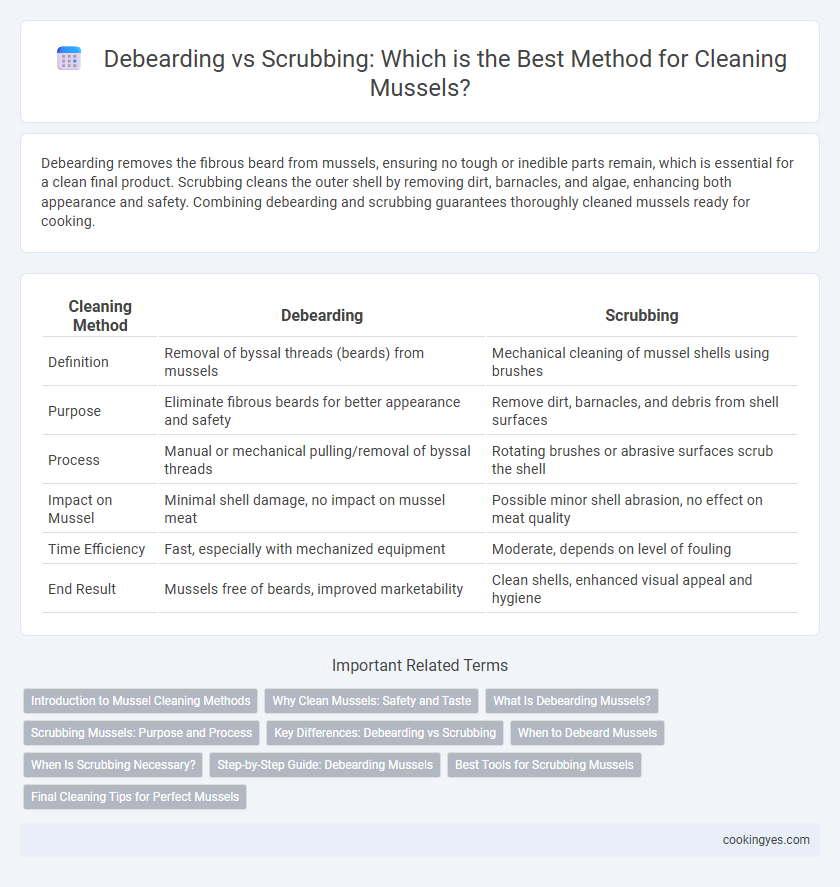Debearding removes the fibrous beard from mussels, ensuring no tough or inedible parts remain, which is essential for a clean final product. Scrubbing cleans the outer shell by removing dirt, barnacles, and algae, enhancing both appearance and safety. Combining debearding and scrubbing guarantees thoroughly cleaned mussels ready for cooking.
Table of Comparison
| Cleaning Method | Debearding | Scrubbing |
|---|---|---|
| Definition | Removal of byssal threads (beards) from mussels | Mechanical cleaning of mussel shells using brushes |
| Purpose | Eliminate fibrous beards for better appearance and safety | Remove dirt, barnacles, and debris from shell surfaces |
| Process | Manual or mechanical pulling/removal of byssal threads | Rotating brushes or abrasive surfaces scrub the shell |
| Impact on Mussel | Minimal shell damage, no impact on mussel meat | Possible minor shell abrasion, no effect on meat quality |
| Time Efficiency | Fast, especially with mechanized equipment | Moderate, depends on level of fouling |
| End Result | Mussels free of beards, improved marketability | Clean shells, enhanced visual appeal and hygiene |
Introduction to Mussel Cleaning Methods
Debearding involves removing the byssal threads or "beard" of the mussel to detach it from surfaces, a crucial step in preparing mussels for consumption. Scrubbing cleans the mussel shell by removing dirt, barnacles, and algae, ensuring the exterior is free of contaminants. Both methods are essential for maintaining mussel quality and safety before cooking.
Why Clean Mussels: Safety and Taste
Cleaning mussels by debearding removes the fibrous beard that can trap sand, dirt, and harmful bacteria, ensuring safer consumption. Scrubbing the shells eliminates external debris and potential contaminants that might affect the flavor and texture. Proper cleaning enhances taste by preventing gritty textures and reduces the risk of foodborne illness linked to shellfish.
What Is Debearding Mussels?
Debearding mussels involves removing the fibrous threads, called byssal threads, that mussels use to attach to surfaces, ensuring they are safe and clean for consumption. This process prevents grit and impurities from contaminating the mussel meat during cooking. Scrubbing, on the other hand, primarily cleans the mussel shell's exterior by removing barnacles and debris but does not address the byssal threads inside.
Scrubbing Mussels: Purpose and Process
Scrubbing mussels removes dirt, barnacles, and debris from the shells' surface, ensuring cleaner seafood and preventing contamination during cooking. The process involves using a stiff brush under cold running water to thoroughly clean each mussel, promoting better cooking results and enhancing food safety. Proper scrubbing also helps inspect and discard any damaged or open mussels that may be unsafe to eat.
Key Differences: Debearding vs Scrubbing
Debearding involves removing the fibrous byssus threads that mussels use to attach to surfaces, ensuring the shell is clean and free from external fibers, while scrubbing targets dirt, algae, and barnacles on the shell's surface. Debearding is typically done by pulling or cutting the beard, which is crucial for preparing mussels for cooking, whereas scrubbing uses brushes to physically clean the shell exterior. Both processes are essential for food safety and quality, but debearding specifically addresses the removal of inedible threads, whereas scrubbing focuses on shell cleanliness.
When to Debeard Mussels
Debearding mussels is essential when the byssal threads are visibly attached, as these fibrous filaments can trap sand and debris, affecting taste and texture. Scrubbing mussels is crucial for removing external dirt and barnacles but does not replace debearding, which should be done before cooking to ensure optimal cleanliness. Ignoring debearding can result in gritty mussels and an unpleasant eating experience.
When Is Scrubbing Necessary?
Scrubbing mussels is necessary when the shells are covered with barnacles, algae, or heavy dirt deposits that cannot be removed by debearding alone. This process involves using a stiff brush under running water to ensure the shell surface is thoroughly cleaned and free of debris. Scrubbing helps prevent grit and contaminants from entering the cooking process, ensuring a cleaner and safer seafood dish.
Step-by-Step Guide: Debearding Mussels
Debearding mussels involves carefully removing the fibrous beard that extends from the shell, preventing sand and debris buildup. Start by grasping the beard near the hinge with your fingers or a cloth and pulling it toward the hinge in a firm, steady motion until it detaches completely. This process protects the mussel's integrity while ensuring it is clean and ready for cooking, unlike scrubbing, which primarily removes surface dirt.
Best Tools for Scrubbing Mussels
Effective scrubbing of mussels requires tools that can withstand rough shells and remove debris without damaging the meat. A stiff nylon brush or a specialized mussel scrubber with firm bristles provides optimal cleaning by removing barnacles, algae, and grit from the shell surface. Using the right scrubbing tool ensures the mussels are thoroughly cleaned, improving safety and enhancing flavor during cooking.
Final Cleaning Tips for Perfect Mussels
Debearding mussels involves removing the fibrous threads, or byssal threads, to prevent grit and ensure a clean shell, while scrubbing mechanically removes debris and barnacles from the outer surface. For perfect mussels, soak them briefly in cold salted water to encourage purging of sand and grit before cooking. Inspect shells for any cracks or open ones that do not close when tapped, discarding these to maintain quality and safety.
Debearding vs Scrubbing for cleaning Infographic

 cookingyes.com
cookingyes.com